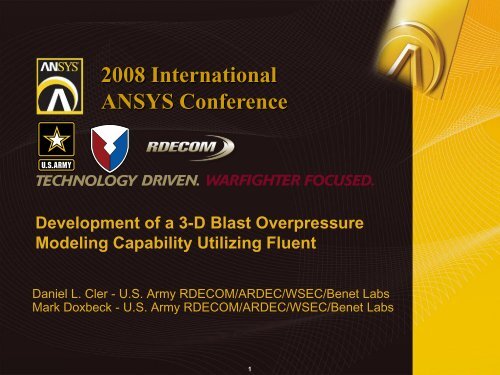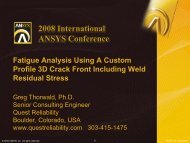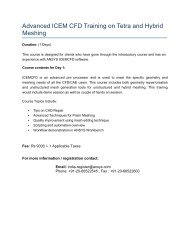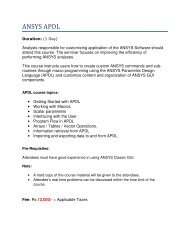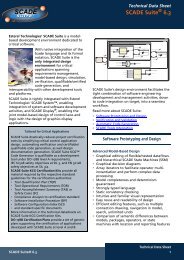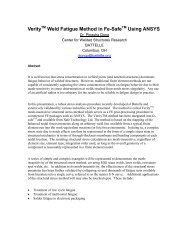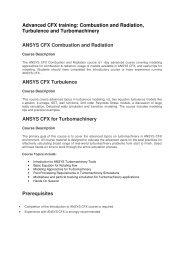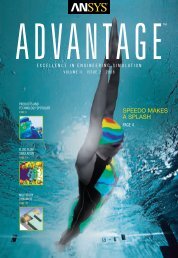View Now - Ansys
View Now - Ansys
View Now - Ansys
You also want an ePaper? Increase the reach of your titles
YUMPU automatically turns print PDFs into web optimized ePapers that Google loves.
2008 International<br />
ANSYS Conference<br />
Development of a 3-D Blast Overpressure<br />
Modeling Capability Utilizing Fluent<br />
Daniel L. Cler - U.S. Army RDECOM/ARDEC/WSEC/Benet Labs<br />
Mark Doxbeck - U.S. Army RDECOM/ARDEC/WSEC/Benet Labs<br />
1
Blast Waves - Examples<br />
Gun blasts Firearm firing<br />
CFD animation of blast wave<br />
2<br />
Blast wave effects on buildings
Blast Waves<br />
• A blast wave is the pressure and flow resulting from the<br />
deposition of a large amount of energy in a small very localized<br />
volume.<br />
– Flow field can be approximated as a lead shock wave, followed by a 'selfsimilar'<br />
subsonic flow field<br />
• Shock waves cause a virtually instantaneous jump in pressure at<br />
the shock front<br />
• The combination of the pressure jump (called the overpressure)<br />
and the dynamic pressure causes blast damage<br />
• It is necessary to understand blast wave to<br />
– Estimate the damage that will result from an explosion<br />
– To devise mechanisms for mitigating the blast<br />
3
Simulation Objective<br />
• Accurate, effective and efficient CFD approach to simulation of<br />
transient shock discontinuities<br />
– Shock wave identification and tracking<br />
– Shock front resolution<br />
– Interaction of shocks with objects<br />
CFD image of a blast wave<br />
4<br />
Blast wave resulting from a pipe burst<br />
in the bleed system of a jetliner
Simulation Approach<br />
• CFD finite-volume utilized rather than Lagrangian<br />
– Lower computational overhead.<br />
– Better flow prediction capabilities.<br />
– Solution based grid adaption.<br />
– Best in situations where blast does not cause<br />
structural deformation.<br />
– Can be coupled to FEA solvers to determine<br />
deformations and loading of structural<br />
components<br />
• Significant improvements to adaptation schemes<br />
are required to make CFD simulations feasible.<br />
5
Modeling Blast Waves<br />
• FLUENT has capability of tracking and<br />
resolving traveling blast waves and<br />
shocks by means of dynamic adaption<br />
– Both refinement and coarsening of the<br />
mesh is performed<br />
• Refinement captures traveling shocks<br />
• Coarsening avoids excessive mesh<br />
resolution away from discontinuities<br />
– Refinement parameters based on<br />
• Gradient of static pressure gradient:<br />
– Static pressure has largest gradient across<br />
shock front<br />
• Solution-based adaption criterion<br />
• In combination, these tools make it<br />
possible to:<br />
– Model the initial combustion<br />
– Track associated blast wave<br />
– Determine the pressure load history on<br />
nearby objects<br />
6
Validation 1 – Small Caliber Gun<br />
Ref: Gun Muzzle Blast and Flash, Progress in Astronautics<br />
and Aeronautics, Vol. 139; Klingenberg, Gunter, Heimerl,<br />
Joseph M., Seebass, A. Richard Editor-in-Chief, AIAA<br />
• Modeling of blast wave associated with a bullet fired<br />
from 7.62 mm NATO G3 rifle with DM 41 round<br />
– Modeling 1 st and 2 nd precursor and main propellant gas<br />
plume without bullet<br />
CFD Analysis Process<br />
• 2-D Axisymmetric<br />
• Fluent 6.1<br />
• Density-based explicit solver with explicit time stepping<br />
• Second-order upwind scheme<br />
• Inviscid<br />
• Species transport of 2 non-reacting ideal gases (propellant &<br />
air)<br />
• Time varying pressure inlet (12.5 mm upstream of the muzzle)<br />
– Existing experimental static pressure as a function of time<br />
• Pressure outlets at computational domain boundaries<br />
• Gun barrel walls are modeled<br />
• Mesh adaption based on pressure gradient<br />
7
Pressure<br />
outlet<br />
Validation 1 – Preprocessing and Results<br />
Pressure-inlet<br />
Quad-paved grid with coarse<br />
spacing near outlet; structured<br />
grid in barrel and tight spacing<br />
near muzzle<br />
1st Pre-Cursor<br />
FLUENT: t = -350 sec t = -5 sec t = -+120 sec<br />
8<br />
2nd Pre-Cursor Main blast wave<br />
Experiment
BWIP Development Rationale<br />
• Standard Gradient Adaption Limitations<br />
– Poor Coarsening after Wave Passes<br />
– Loss of Adaption as Blast Wave Weakens<br />
– Over-adaption in Uncritical Areas<br />
– Unable to Utilize Advance Register Combinations to<br />
Improve Performance<br />
• Blast Wave Identification Parameter (BWIP)<br />
– Track Primary and Reflected Waves<br />
– Ignore Other Pressure Gradients<br />
– Fine Control of Adaption Level on Shock Fronts<br />
9
Validation 2 - 3D Tank Gun Blast<br />
Ref: Kurbatskii, K. A., Montanari, F., Cler, D. L., and<br />
Doxbeck, M., “Numerical Blast Wave Identification and<br />
Tracking Using Solution-Based Mesh Adaptation<br />
Approach”, AIAA Paper 2007-4188<br />
• Structures of blast waves associated with<br />
firing of a ballistic weapon are very<br />
complicated<br />
• In different regions, shockwaves can have<br />
quite different strengths<br />
• There are no universal criteria for the<br />
accurate numerical detection of<br />
shockwaves<br />
• U.S. Army has been studying blast wave<br />
propagation numerically to propose<br />
methods of minimizing the impact of gun<br />
blasts on tank crews<br />
• New blast wave identification parameter<br />
(BWIP) based on the flow physics capable<br />
of locating traveling shocks with disparate<br />
strengths automatically with minimal user<br />
set-up is used<br />
10<br />
Experimental set-up of 120 mm<br />
Advanced Technology<br />
Demonstrator (ATD)
Validation 2 – Mesh and Solution-based<br />
Adaption Parameter<br />
Initial mesh: 330,000<br />
tetrahedral cells<br />
Solution-based Blast Wave Identification<br />
Parameter (BWIP)<br />
• For any shock, the Mach vector normal to the shock<br />
has a value of at least one just before the shock<br />
• This normal Mach number is used as a test value for<br />
determining the shock location<br />
• Pressure gradient is always normal to the shock, and<br />
it is used to find the shock orientation<br />
• Dot product of the pressure gradient with the Mach<br />
number vector is used to calculate a shock test value<br />
in each cell<br />
• Locations where the test value equals to one forms a<br />
boundary surrounding the shock locations<br />
• A correction is applied to the test equation to account<br />
for the moving shock<br />
• Utilize user defined functions.<br />
11
Validation 2 - CFD Analysis Process<br />
• FLUENT 6.3 or later<br />
• Density-based explicit double-precision solver<br />
• Inviscid flow<br />
• Species transport of two non-reacting ideal<br />
gases (propellant and air)<br />
• 1 st -order upwind scheme<br />
• Standard upwind flux-difference splitting of<br />
Roe to evaluate fluxes<br />
• Green-Gauss node-based gradient evaluation<br />
• Explicit time stepping approach<br />
• time step determined by the CFL condition<br />
• 4-stage Runge-Kutta scheme with standard<br />
coefficients for time integration<br />
• Mesh adaption based on the BWIP function<br />
• Outflow boundary is a pressure outlet<br />
• Computations are completed before<br />
propagating shocks reach outflow boundaries<br />
12<br />
120 mm ATD firing<br />
FLUENT simulation
Validation 2 - Results<br />
Mesh Static pressure<br />
Static pressure on tank chassis<br />
13
Ps<br />
Ps<br />
0<br />
Validation 2 - Results<br />
h09<br />
1500 2000 2500 3000 3500 4000 4500 5000<br />
h13<br />
t, sec<br />
Fluent with adaption<br />
Fluent without adaption<br />
test<br />
0<br />
1500 2000 2500 3000 3500 4000 4500 5000<br />
t, sec<br />
Fluent with adaption<br />
Fluent without adaption<br />
test<br />
14<br />
Ps<br />
Ps<br />
0<br />
h10<br />
1500 2000 2500 3000 3500 4000 4500 5000<br />
h14<br />
t, sec<br />
Fluent with adaption<br />
Fluent without adaption<br />
test<br />
0<br />
1500 2000 2500 3000 3500 4000 4500 5000<br />
t, sec<br />
h14 - Fluent with adaption<br />
h14 - Fluent without adaption<br />
h14 - test<br />
Numerical and experimental time histories of pressure at four hull locations. Also shown<br />
numerical results computed on the original mesh without adaption
Advanced BWIP Development<br />
max<br />
p<br />
• Utilizes to determine shock location.<br />
• Identifies shock center based on above.<br />
• Marks cells a prescribed distance from shock center.<br />
• Mark cells based on mass fraction of propellant.<br />
• Combines registers.<br />
<br />
V<br />
min<br />
• Creates a buffer zone in front of shock based on dot<br />
product of vector defined by two cell centroids and a<br />
velocity vector<br />
• Grid adaption frequency controlled based on time for shock<br />
to pass to edge of buffer zone.<br />
• U.S. Patent Application # 60/944,612 Filed on 6/18/07<br />
15
Validation 3 – LAEP 6<br />
• New Muzzle Brake<br />
• Improved Experimental<br />
Instrumentation<br />
– Field Probes<br />
• Advanced BWIP<br />
• Improved Chemical<br />
Species Determination<br />
16
Validation 3 – Side-on Pressure<br />
17
Validation 3 – Adaption Capabilities<br />
18
Validation 3 – Maximum Overpressure<br />
19
Validation 3 – Animation 1<br />
20
Validation 3 – Animation 2<br />
21
Validation 3 – Animation 3<br />
22
Validation 4 – Fixed Mesh vs BWIP<br />
Fixed Mesh - 976,422 cells<br />
23<br />
Adaption Mesh - 94,344 cells
Cumulative CPU Time (days)<br />
14<br />
12<br />
10<br />
Validation 4 – Performance Comparison<br />
8<br />
6<br />
4<br />
2<br />
Fixed Mesh<br />
BWIP<br />
Advanced BWIP<br />
0<br />
0 1 2 3 4 5 6 7 8 9 10 11<br />
Flow Time (ms)<br />
Number of Cells<br />
24<br />
3.5<br />
3<br />
2.5<br />
2<br />
1.5<br />
x 105<br />
4<br />
1<br />
BWIP<br />
Advanced BWIP<br />
0.5<br />
0 1 2 3 4 5 6 7 8 9 10 11<br />
Flow Time (ms)
Overpressure (psi)<br />
15<br />
10<br />
Validation 4 –<br />
Static Pressure Probe Comparison<br />
5<br />
0<br />
f02<br />
Fixed Mesh<br />
BWIP<br />
Advanced BWIP<br />
4 4.5 5 5.5 6<br />
Time (ms)<br />
6.5 7 7.5 8<br />
25<br />
Overpressure (psi)<br />
12<br />
10<br />
8<br />
6<br />
4<br />
2<br />
0<br />
f06<br />
Fixed Mesh<br />
BWIP<br />
Advanced BWIP<br />
4 4.5 5 5.5 6<br />
Time (ms)<br />
6.5 7 7.5 8
Validation 4 – Performance Comparison<br />
• 2-D Comparison<br />
– Advanced BWIP is 8 times faster.<br />
– Slight reduction in quality at farfield locations.<br />
• 3-D Comparison<br />
– Advanced BWIP would be 2 orders of<br />
magnitude faster than fixed mesh based on 2-<br />
D performance comparison.<br />
– Quality should only be slightly degraded.<br />
– Advanced BWIP makes 3-D blast simulation<br />
feasible.<br />
26
Conclusions<br />
• High-quality 3-D blast analysis capability in<br />
Fluent through Advanced BWIP user defined<br />
function with very low computational overhead.<br />
• Better solution accuracy and lower computational<br />
cost than traditional Lagrangian blast simulation<br />
methods.<br />
• Validated against real world problems with good<br />
prediction accuracy.<br />
• Technology is licensable from RDECOM.<br />
27


